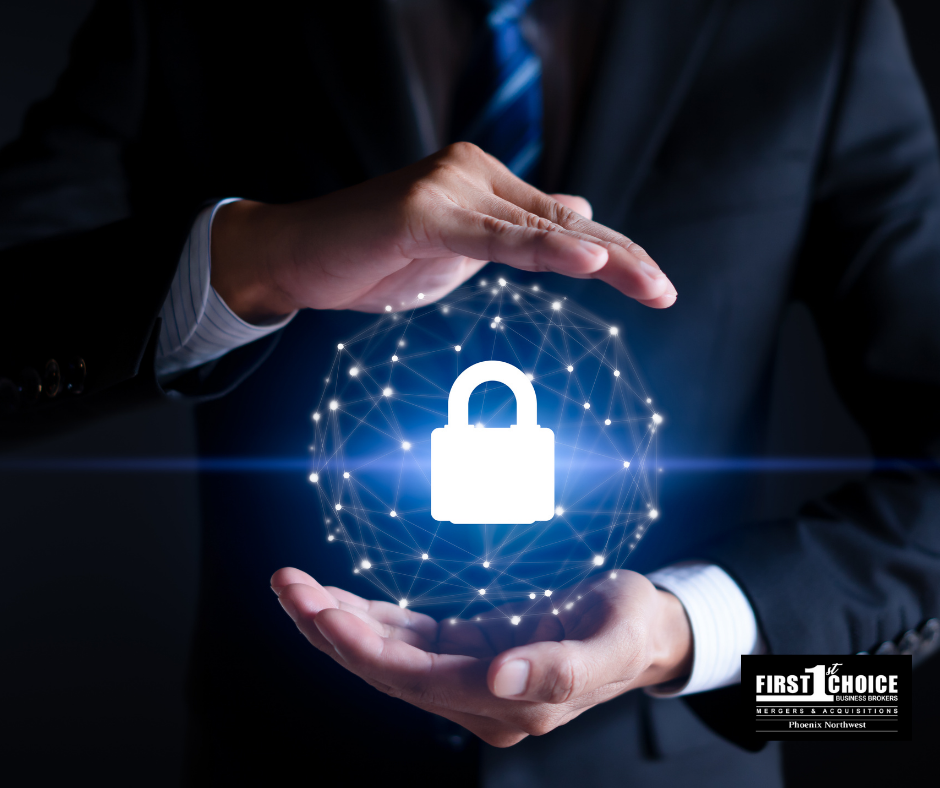Cybersecurity Trends: Protecting Your Business in 2024

In the rapidly evolving digital landscape of 2024, cybersecurity has become a paramount concern for businesses of all sizes. With cyber threats growing more sophisticated, it is crucial for business owners to stay ahead of potential risks and implement robust security measures. As a business broker, I have witnessed firsthand the devastating impact of cyberattacks on companies, from financial losses to irreparable damage to their reputation.
This blog aims to shed light on the latest cybersecurity trends and provide practical tips to safeguard your business. By understanding and adapting to these trends, you can ensure the longevity and success of your enterprise in today's interconnected world.
Key Takeaways
- Embrace Zero Trust Architecture: Adopt a security model that assumes threats are present both inside and outside the network.
- Invest in AI and Machine Learning: Leverage advanced technologies for proactive threat detection and response.
- Strengthen Supply Chain Security: Collaborate with vendors to mitigate risks and enhance overall security.
- Enhance Employee Training: Educate staff on cybersecurity best practices and phishing awareness.
- Prepare for Ransomware Attacks: Develop a robust incident response plan to quickly address ransomware threats.
Embrace Zero Trust Architecture
Zero Trust Architecture (ZTA) is gaining traction as a robust cybersecurity framework. Unlike traditional security models that trust users within the network, ZTA operates on the principle of "never trust, always verify." This means every access request, whether from inside or outside the network, is thoroughly authenticated, authorized, and encrypted before granting access. ZTA requires strict identity verification and access controls, continuously validating the legitimacy of users and devices.
Scenario
Imagine a mid-sized e-commerce business experiencing a surge in cyberattacks. Despite having firewalls and antivirus software, they faced multiple breaches due to malicious insiders and compromised credentials. By transitioning to ZTA, the company could implement strict access controls, continuous monitoring, and micro-segmentation, effectively minimizing the attack surface and significantly enhancing their security posture. The company also integrated multi-factor authentication (MFA) and advanced encryption protocols to ensure that sensitive customer data remained protected at all times.
To successfully implement Zero Trust Architecture:
- Map out your network and identify critical assets.
- Define strict access policies, ensuring that only authorized personnel can access sensitive data.
- Regularly update and patch your systems to address vulnerabilities.
- Continuously monitor network activity for any signs of suspicious behavior.
- Collaborate with cybersecurity experts to tailor a ZTA framework that aligns with your business needs.
Invest in AI and Machine Learning
Artificial Intelligence (AI) and Machine Learning (ML) are revolutionizing the cybersecurity landscape. These technologies enable businesses to detect anomalies, predict potential threats, and respond to incidents in real-time. AI-driven security solutions can analyze vast amounts of data, identify patterns, and automatically mitigate risks. With AI and ML, businesses can achieve faster detection and response times, reducing the window of opportunity for cybercriminals.
Sample
Consider a financial firm that handles sensitive client data. By integrating AI and ML into their security systems, they can proactively identify unusual transaction patterns, flagging potential fraud before it occurs. For instance, if an unauthorized user attempts to access the system outside of normal business hours, the AI system can automatically block the access and alert the security team. This proactive approach not only prevents financial losses but also builds trust with their clients by demonstrating a commitment to robust security measures.
To maximize the benefits of AI and ML:
- Invest in advanced security platforms that offer AI-driven threat detection and response capabilities.
- Train your IT team to understand and manage these technologies effectively.
- Regularly update your AI models to adapt to evolving threats and ensure that your security infrastructure remains resilient.
- Collaborate with AI experts to develop customized solutions that address your specific security challenges.
Strengthen Supply Chain Security
The interconnected nature of today's business environment means that your security is only as strong as the weakest link in your supply chain. Cybercriminals often target smaller, less secure vendors to gain access to larger organizations. Therefore, it's vital to assess and enhance the security measures of all your partners and suppliers. Supply chain security involves evaluating the cybersecurity posture of every entity you do business with, from raw material suppliers to third-party service providers.
Scenario
A large manufacturing company suffered a data breach due to a compromised vendor. The vendor had weak security protocols, and cybercriminals exploited this vulnerability to gain access to the manufacturing company's network. As a result, sensitive product designs and intellectual property were stolen, causing significant financial and reputational damage. To prevent such incidents, the manufacturing company decided to implement a comprehensive third-party risk management program, conducting regular security audits and enforcing strict cybersecurity standards across its supply chain.
Tips:
- Conduct regular security audits and require vendors to comply with your cybersecurity standards.
- Develop a comprehensive third-party risk management program that includes detailed contracts and continuous monitoring.
- Use risk assessment tools to evaluate the cybersecurity posture of your suppliers and partners.
- Establish clear communication channels to promptly address any security concerns or breaches within the supply chain.
- Ensure that your entire supply chain is secure and resilient against cyber threats.
Enhance Employee Training
Human error remains one of the leading causes of cybersecurity breaches. Ensuring that your employees are well-versed in cybersecurity best practices is essential. Regular training sessions can help staff recognize phishing attempts, use strong passwords, and follow proper data handling protocols. Comprehensive employee training programs should cover various aspects of cybersecurity, from basic awareness to advanced threat detection techniques.
Sample
A retail company experienced a significant data breach after an employee fell victim to a phishing email. The email appeared to be from a trusted source, prompting the employee to click on a malicious link and enter sensitive login credentials. To prevent future incidents, the company implemented a mandatory cybersecurity training program for all employees. The training included simulated phishing attacks to test their awareness and provide feedback on how to improve. Employees were also educated on the importance of using strong, unique passwords and the risks associated with public Wi-Fi networks.
To avoid employee cybersecurity breach:
- Implement a mandatory cybersecurity training program for all employees.
- Use simulated phishing attacks to test their awareness and provide feedback on how to improve.
- Encourage a culture of vigilance where employees feel empowered to report suspicious activities without fear of repercussions.
- Regularly update the training materials to address new threats and ensure that employees stay informed about the latest cybersecurity trends.
- Foster a sense of responsibility among employees, emphasizing that cybersecurity is a collective effort.
Prepare for Ransomware Attacks
Ransomware attacks have become increasingly prevalent, with cybercriminals targeting businesses of all sizes. Developing a robust incident response plan is crucial to minimize the impact of such attacks. This plan should include regular data backups, clear communication protocols, and predefined roles and responsibilities. A comprehensive incident response plan ensures that your organization can quickly and effectively respond to ransomware threats, minimizing downtime and financial losses.
Scenario
A healthcare provider fell victim to a ransomware attack, crippling their operations and risking patient data. Fortunately, they had an incident response plan in place. They quickly isolated affected systems, notified law enforcement, and initiated their backup recovery process. As a result, they were able to restore critical functions and mitigate data loss. The healthcare provider also conducted a thorough investigation to identify the root cause of the attack and implement additional security measures to prevent future incidents.
Tips:
- Develop a robust incident response plan:
- Include regular data backups
- Establish clear communication protocols
- Define roles and responsibilities
- Ensure backups are stored:
- Offline
- In a secure cloud environment, separate from the main network
- Conduct regular drills:
- Test the effectiveness of the response plan
- Identify areas for improvement
- Establish relationships with:
- Cybersecurity experts
- Law enforcement agencies
- Stay informed about:
- The latest ransomware threats
- Tactics to adapt your defenses accordingly
Conclusion
In 2024, cybersecurity is not just a technical issue but a fundamental aspect of business strategy. By staying informed about the latest trends and implementing robust security measures, you can protect your business from the ever-evolving landscape of cyber threats. As a business broker, I emphasize the importance of proactive cybersecurity to ensure the long-term success and resilience of your enterprise. Stay vigilant, invest in the right technologies, and foster a culture of security within your organization.
FAQ
What is Zero Trust Architecture, and why is it important?
Zero Trust Architecture is a security model that operates on the principle of "never trust, always verify," ensuring that every access request is thoroughly authenticated and authorized. It is important because it minimizes the attack surface and enhances security by assuming that threats can come from both inside and outside the network.
How can AI and Machine Learning improve cybersecurity?
AI and Machine Learning can improve cybersecurity by analyzing vast amounts of data, identifying patterns, and predicting potential threats in real-time. These technologies enable proactive threat detection and response, reducing the likelihood of successful cyberattacks.
What should be included in a ransomware incident response plan?
A ransomware incident response plan should include regular data backups, clear communication protocols, predefined roles and responsibilities, and steps for isolating affected systems. It should also involve notifying law enforcement and initiating the backup recovery process to restore critical functions.
Get in Touch:
First Choice Business Brokerage Phoenix
📍 21640 N 19th Ave Suite C9, Phoenix, AZ 85027
📞 (623) 888-6190
Recent articles for you




